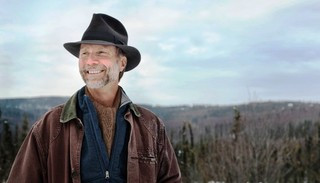|
Back
Summit-Time, and the Playing Is Hardly Easy New York
Church of the Intercession
10/21/2019 -
John Luther Adams: String Quartet No. 1: The Wind in High Places – String Quartet No. 5: Lines Made by Walking: a. Up the Mountain; b. Along the Ridge; c. Down the Mountain (New York Premiere)
JACK Quartet: Christopher Otto, Austin Wulliman (Violins), John Pickford Richards (Viola), Jay Campbell (Cello)

J. L. Adams (© Evan Hurd)
“My hope is that the music creates a strange, beautiful, overwhelming - sometimes even frightening - landscape, and invites you to get lost in it.”
John Luther Adams (1953– )
“You are not in the mountains. The mountains are in you.”
John Muir (1838-1914)
In theory, the very last place to perform the music of John Luther Adams is Church of the Intercession Crypt.
Like the first American naturalist John Muir, Adams has spent most of his 65 years vigorously climbing and hiking and surveying and ascending and descending and transubstantiating into music the forests and mountains of Alaska. A crypt, though, is cloistered. Unlike Muir and Adams, who lived to be superlatively alive, crypts are made for the dead.
Yet if the mountains are indeed within us, and if Mr. Adams can project a musical notion of the endlessly wide challenges within our own anatomies, there was no question that the JACK Quartet could essay this experiment in ascending and descending.
The result was intriguing, and–like all of Mr. Adams’ work–flowing and insistent. It was a picture, of course. But 21st Century pictures lie in the mind of the picture-maker. To the viewer, such personal images can be amorphous. Thus, Lines Made by Walking could have been named Streams Coursing to Ocean, or Pines Rise, Fall. But this was Mr. Adams following the same path as Strauss’ Alpine Symphony and Ruggles’ Men and Mountains.
And making it his own.

JACK Quartet (© Beowulf Sheehan)
For the most logical reasons, Mr. Adams has chosen JACK Quartet as his virtual quartet-in-residence. He is now working on two more quartets, reportedly, and JACK, one of the many descendants of Kronos, has the virtuosity, the artistry, the no-nonsense performance and–above all–the understanding of contemporary artists.
When John Luther Adams’ First Quartet seems to denote all open strings, natural harmonics, virtually devoid of vibrato, these four players don’t take advantage of the composer by sneaking in a few untoward emotions. This work, The Wind in High Places, in three short movements, seems simple on the surface, the players hardly touching their fingerboards. Somehow, Mr. Adams (and his JACK) produce almost ghostly, almost moribund tones. Yet in the second part, with all four instruments playing in the highest registers, with violins playing harmonics, we have the replica of bells. Soft and loud church bells or mourning bells.
It is a startling effect, for a short and startling opening, these four instruments melding into one, with 16 strings playing on a single instrument.
The major work was the Fifth Quartet. And if much of the upward-download trudging seems like a chamber imitation of Alpine Symphony...well, so be it. Mr. Adams certainly never meant it that way. But certain physical movements (climbing, descending) can’t really be changed.
What seemed obvious to this listener was that the “walking lines” were made by four people. Virtually everything here was canonic–though canons with vast impenetrable diversions. The rise did indeed rise, but the one motive ran (rather, walked) after each other. On top of the mountain, the instruments seemed to encounter a variety of landscapes, they encountered–rather, they saw vast meadows, canyons, perhaps an animal or two. JACK Quartet had time to saunter and enjoy, again following each other.
The last descent did indeed seem Straussian. Yet John Luther Adams never made the descent easy. A canon is a strict form. The composer here took liberties, extended times, durations, stopped started...
And then, all too soon, the end of the trail. Except that, as John Muir said, that mountain was within us. Mr. Adams’ music hardly stays inside us like a Verdi tune or a Schubert song. The resonance, though, the JACK Quartet resonance which vibrated through the crypt, became both unsettling for its Adams strange movements, and as comfortable as (for this listener) reaching the apex of Mount Kilimanjaro. The finish was not a great “Amen”. It was the consolation that, after the first mountain of our Alaska or our minds, we have many summits remaining.
Harry Rolnick
|